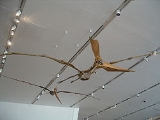
Pterosaur
Overview
Pterosaurs were flying reptile
s of the clade
or order
Pterosauria. They existed from the late Triassic
to the end of the Cretaceous
Period (220 to 65.5 million years ago). Pterosaurs are the earliest vertebrate
s known to have evolved powered flight. Their wings were formed by a membrane of skin, muscle, and other tissues
stretching from the legs to a dramatically lengthened fourth finger. Early species had long, fully toothed jaws and long tails, while later forms had a highly reduced tail, and some lacked teeth.
Reptile
Reptiles are members of a class of air-breathing, ectothermic vertebrates which are characterized by laying shelled eggs , and having skin covered in scales and/or scutes. They are tetrapods, either having four limbs or being descended from four-limbed ancestors...
s of the clade
Clade
A clade is a group consisting of a species and all its descendants. In the terms of biological systematics, a clade is a single "branch" on the "tree of life". The idea that such a "natural group" of organisms should be grouped together and given a taxonomic name is central to biological...
or order
Order (biology)
In scientific classification used in biology, the order is# a taxonomic rank used in the classification of organisms. Other well-known ranks are life, domain, kingdom, phylum, class, family, genus, and species, with order fitting in between class and family...
Pterosauria. They existed from the late Triassic
Triassic
The Triassic is a geologic period and system that extends from about 250 to 200 Mya . As the first period of the Mesozoic Era, the Triassic follows the Permian and is followed by the Jurassic. Both the start and end of the Triassic are marked by major extinction events...
to the end of the Cretaceous
Cretaceous
The Cretaceous , derived from the Latin "creta" , usually abbreviated K for its German translation Kreide , is a geologic period and system from circa to million years ago. In the geologic timescale, the Cretaceous follows the Jurassic period and is followed by the Paleogene period of the...
Period (220 to 65.5 million years ago). Pterosaurs are the earliest vertebrate
Vertebrate
Vertebrates are animals that are members of the subphylum Vertebrata . Vertebrates are the largest group of chordates, with currently about 58,000 species described. Vertebrates include the jawless fishes, bony fishes, sharks and rays, amphibians, reptiles, mammals, and birds...
s known to have evolved powered flight. Their wings were formed by a membrane of skin, muscle, and other tissues
Tissue (biology)
Tissue is a cellular organizational level intermediate between cells and a complete organism. A tissue is an ensemble of cells, not necessarily identical, but from the same origin, that together carry out a specific function. These are called tissues because of their identical functioning...
stretching from the legs to a dramatically lengthened fourth finger. Early species had long, fully toothed jaws and long tails, while later forms had a highly reduced tail, and some lacked teeth.
Unanswered Questions

